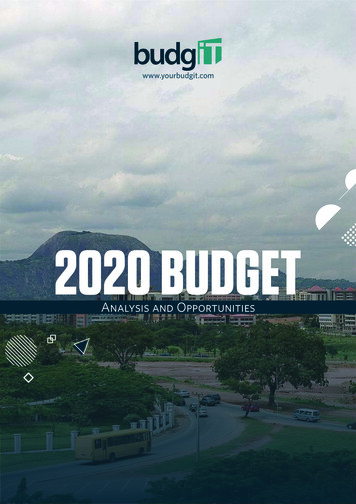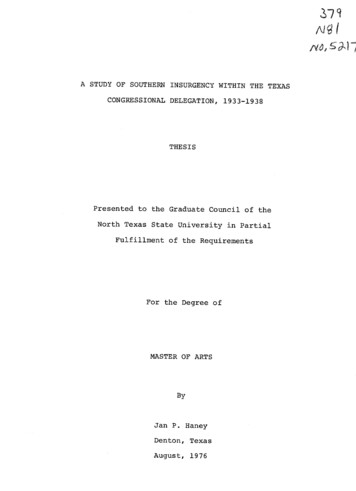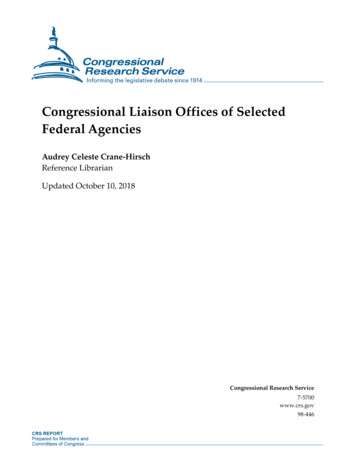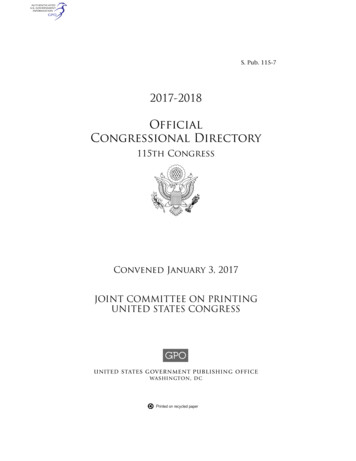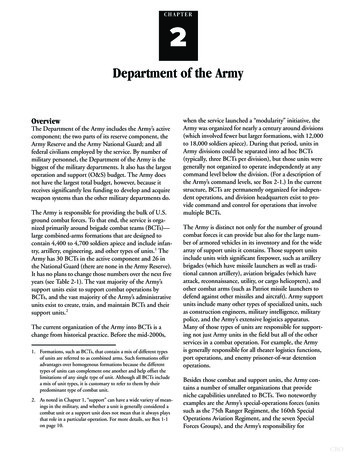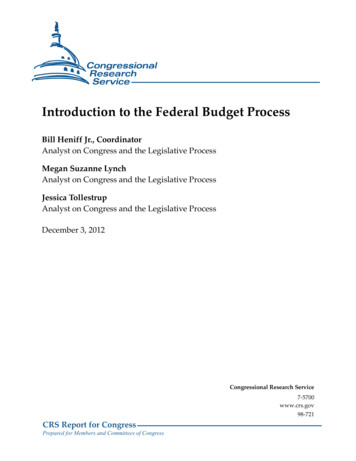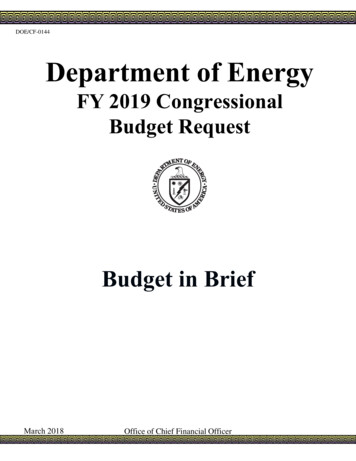
Transcription
DOE/CF-0144Department of EnergyFY 2019 CongressionalBudget RequestBudget in BriefMarch 2018Office of Chief Financial Officer
DOE/CF-0144Department of EnergyFY 2019 CongressionalBudget RequestBudget in BriefMarch 2018Office of Chief Financial OfficerPrinted with soy ink on recycled paper
FY 2019 BUDGET IN BRIEFTABLE OF CONTENTSOverview . 1Funding by Appropriation . 10Funding by Organization . 11Nuclear SecurityNational Nuclear Security Administration . 12Federal Salaries and Expenses . 13Weapons Activities . 15Defense Nuclear Nonproliferation . 19Naval Reactors . 23Energy ProgramsEnergy Efficiency and Renewable Energy . 25Electricity Delivery . 30Power Marketing Administrations . 33Cybersecurity, Energy Security, and Emergency Response . 35Petroleum Accounts . 37Fossil Energy Research and Development . .39Nuclear Energy . 42Yucca Mountain and Interim Storage . 44Environment, Health, Safety and Security Mission Support . 45Credit ProgramsTitle 17 – Innovative Technology Loan Guarantee Program . 47Advanced Technology Vehicles Manufacturing Loan Program. 48Science and Environment and Legacy ManagementScience. 49Environmental Management . 53Legacy Management . 57Other Department OfficesDepartmental Administration . 58Enterprise Assessments . 60Hearings and Appeals . 62Energy Information Administration. 63Inspector General . 64Federal Energy Regulatory Commission . 66
OVERVIEWThe President’s Budget for FY 2019 requests 30.6B for the Department of Energy (DOE) to advance U.S.national security and economic growth through transformative science and technology innovation thatpromotes affordable and reliable energy through market solutions and meets our nuclear security andenvironmental cleanup challenges.The FY 2019 Budget Request provides:DEPARTMENT OF ENERGY 15.1B to modernize and restore the nuclear securityenterprise aligned with the Nuclear Posture Review(NPR) and National Security Strategy 5.4B to conduct cutting‐edge, early‐stage scientificresearch and development (R&D) and build state‐of‐the‐art scientific tools and facilities to keep U.S.researchers at the forefront of scientific innovation,including achieving exascale computing in 2021 2.5B to promote America’s energy dominance through technologies that will make our energy supply moreaffordable, reliable, and efficient 6.6B to continue our commitment for the cleanup of sites resulting from five decades of nuclear weaponsdevelopment and production and Government‐sponsored nuclear energy researchDOE ProgramsFY19 ( M) National Nuclear Security Administration 15,091 Science5,391 Energy2,515 Environmental Management6,601 Other Defense Activities853 Administration and Oversight293 Savings and Receipts‐137DOE Total30,609ACCELERATING PROGRESS ON NATIONAL PRIORITIESThe FY 2019 Budget Request advances key mission areas through significant investments to, achieve exascalecomputing, protect the national electric grid from cyberattack, promote energy dominance, conduct early stagescientific research, modernize the nuclear security enterprise, and advance the nation’s nuclear wastemanagement program.The FY 2019 Budget Request funds 636M to achieve exascale computing in 2021, including 473M in the Officeof Science and 163M in NNSA, 376M above the FY 2017 Enacted level, to support development of an exascalecomputing software ecosystem by preparing mission critical applications to address exascale challenges. TheBudget Request funds research, development, and design at the Argonne National Laboratory and Oak RidgeNational Laboratory with expected deployment of an exascale‐capable computing system in 2021 with a secondsystem with a different architecture in 2022. This Science/NNSA partnership will bolster America’s nationalsecurity by supporting the nuclear stockpile while supporting the next generation of science breakthroughs notpossible with today’s fastest computing systems.The Request also invests 105M in quantum computing to address the emerging urgency of building U.S.competency and competitiveness in the developing area of quantum information science, including quantumcomputing and quantum sensor technology. This early stage, fundamental research will concentrate onaccelerating progress towards application of quantum computing techniques and quantum sensing to grandchallenge science questions. It also builds on experience gained from multidisciplinary partnerships in areassuch as quantum pattern recognition for real‐time tracking; quantum algorithms for exponentially increasedinformation storage, quantum chemistry, and nuclear physics; and predictive capability for biological systemssuch as protein folding.Budget in Brief1FY 2019 Congressional Budget Justification
National and economic security also depends on the reliable function of the Nation’s overall energyinfrastructure in face of the threat posed by malicious cyber actors. Cybersecurity is one of the Administration’stop priorities, and the FY 2019 Budget Request provides funding in multiple programs to prevent and addresscyberattacks on the energy sector and to secure the DOE enterprise.The Request supports the Administration’s commitment to protecting energy infrastructure security byproposing a separate account for Cybersecurity, Energy Security, and Emergency Response (CESER). This newaccount will consolidate funding that supports the expanded national security responsibilities assigned to DOEthrough the Fixing America’s Surface Transportation (FAST) Act, Bipartisan Budget Act of 2015, Presidential PolicyDirective 21, and Presidential Executive Order 13800 on Cybersecurity. As part of CESER, the FY 2019 BudgetRequest provides 70M for grid cybersecurity. Pursuant to the Federal Power Act, as amended by the FAST Act,DOE remains the sector‐specific agency for cybersecurity in the energy sector. As such, DOE is working with theprivate sector to prepare, mitigate vulnerabilities and help reduce impacts from cyber threats. The FY 2019Budget Request will help improve preparedness, planning and response capabilities for cyber incidents and helpalign them across state, local, tribal, territorial and Federal jurisdictions. In addition, the Budget Request will helpleverage the cutting‐edge R&D of DOE’s national labs to drive cybersecurity innovation across the energy sector.Also, the Request includes 394.5M for DOE Enterprise cybersecurity, an increase of 98M from the FY 2017Enacted amount, to reduce DOE exposure to threats and to manage enterprise cybersecurity risks. This includes 92M for the Department’s Office of Chief Information Officer, 23M above FY 2017 Enacted level, to reducethe Department’s exposure to threats and to manage enterprise cybersecurity risks. The Budget Request alsoincludes over 300M in other program office budgets to support improved DOE cybersecurity, including 185Mfor the cybersecurity of the National Nuclear Security Administration.The FY 2019 Budget Request continues to focus the Department’s energy ( 2.5B) and science ( 5.4B) programson early‐stage R&D at the national laboratories to advance American primacy in scientific and energy research inan efficient and cost effective manner. The Budget Request focuses on cutting‐edge innovation. For example,the Request funds 432M for specific, cutting‐edge, early‐stage R&D efforts in energy storage solutions beyondbatteries, advanced fossil‐based power systems, and advanced reactor technologies including Small ModularReactors to promote American energy dominance through an “all of the above” energy strategy. The Requestalso fosters the transition of those breakthroughs to the private sector for commercialization through expandedfunding for a consolidated technology transitions function in the Office of Technology Transitions ( 8.5M). TheBudget Request eliminates the Advanced Research Projects Agency—Energy program, the Title XVII InnovativeTechnology loan guarantee program, and the Advanced Technology Vehicle Manufacturing loan program.The FY 2019 Budget Request provides 11B to NNSA to modernize the nuclear security enterprise, 1.8B aboveFY 2017, including the ongoing refurbishment of the nuclear weapon stockpile, in alignment with the 2018 NPR.Finally, demonstrating the Administration’s commitment to nuclear waste management the Request of 120Mresumes support for the Yucca Mountain licensing process and develops and implements a robust interimstorage program. The Yucca Mountain and Interim Storage programs are critical to enhancing the national andeconomic security goals of the nation.NATIONAL NUCLEAR SECURITY ADMINISTRATIONThe National Nuclear Security Administration (NNSA) is responsible for maintaining a safe, secure, and effectivenuclear weapons stockpile; for preventing, countering, and responding to evolving and emerging nuclearproliferation and terrorism threats; for providing safe, reliable and long‐term nuclear propulsion to the Nation’sNavy as it protects American and Allied interests around the world; and for supporting the federal workforcethat carries out these critical responsibilities.Budget in Brief2FY 2019 Congressional Budget Justification
To support these activities, the FY 2019 Budget RequestNATIONAL NUCLEAR SECURITY ADMINISTRATIONproposes 15.1B for the NNSA, 2.2B over FY 2017 Enacted.The Request makes necessary investments consistent withNNSA ProgramsFY19 ( M) Weapons Activities11,017the NPR to: modernize and rebuild a nuclear force and Defense Nuclear Nonproliferation1,863nuclear security enterprise; prevent, counter and respond Naval Reactors1,789to nuclear proliferation and terrorism threats; and provide Federal Salaries and Expenses423safe, reliable, and long‐term nuclear propulsion to theNNSA Total15,091Nation’s Navy. The Nuclear Weapons Council (NWC) willtranslate the NPR’s policy initiatives into requirements. This request positions NNSA to support those initiativeswhile working within the NWC to define the military requirements and strategic direction provided by the NPR.As military requirements are refined, the Administration will work with Congress to ensure that the program ofwork is properly authorized and funded.The Budget Request includes: 11B for Weapons Activities, 1.8B above FY 2017 Enacted, to maintain the safety, security, andeffectiveness of the nuclear stockpile, to continue the nuclear modernization program, and to modernizeNNSA’s nuclear security infrastructure portfolio in alignment with the NPR.o 1.9B for Life Extension Programs (LEPs), 580M above FY 2017 Enacted, to support the nuclearweapons program. The FY 2019 Budget Request supports the LEP and Major Alterations (Alt) includingthe W80‐4 LEP, the W88 Alt 370, completion of the W76‐1 LEP, transition from design to production forthe B61‐12 LEP, and restart of the Feasibility Study & Design Options for Interoperable Warhead‐1 (IW‐1) to remain aligned with the Department of Defense (DOD) current nuclear modernization plans.o 3.0B for Infrastructure and Operations, 194M above FY 2017, to continue the long‐term effort toreverse the declining state of NNSA infrastructure, improve working conditions of NNSA’s deterioratingfacilities and equipment, and address safety and programmatic risks. The Request funds construction ofthe Uranium Processing Facility (UPF) and associated buildings; continued construction of the Chemistryand Metallurgical Research Replacement (CMRR) project to sustain plutonium science activities; andconstruction of the Albuquerque Complex Project to replace aging and degrading facilities.o 163M for activities and research leading to deployment of exascale capability for national securityapplications. Of this 47M is designated for two construction projects: 1) 24M for the Exascale ClassComputer Cooling Equipment (EC3E) project at the Los Alamos National Laboratory (LANL), and 2) 23Mfor the Exascale Computing Facility Modernization (ECFM) project at the Lawrence Livermore NationalLaboratory (LLNL). 1.9B for Defense Nuclear Nonproliferation, 17M below FY 2017 Enacted, to address the entire nuclearthreat spectrum by preventing the acquisition of nuclear weapons or weapons‐usable materials, counteringefforts to acquire such weapons or materials, and responding to nuclear or radiological incidents. TheBudget Request also includes 220M to continue the orderly and safe closure of the Mixed Oxide (MOX)Fuel Fabrication Facility and 59M for the Surplus Plutonium Disposition (SPD) project to support the diluteand dispose strategy. The Budget Request will support the continuation of preliminary design and theinitiation of long‐lead procurements in FY 2019. 1.8B for Naval Reactors (NR), an increase of 369M from the FY 2017 level (excluding the transfer of 75Mto the Office of Nuclear Energy to support the Advanced Test Reactor), to support the current and futurefleet. The request funds continued research, development and design for the Columbia‐class submarine,recapitalizing the capability to handle naval spent nuclear fuel, and continued work to ensure the fleetremains the most advanced, well‐maintained, and capable nuclear fleet in the world.Budget in Brief3FY 2019 Congressional Budget Justification
423M for NNSA Federal Salaries and Expenses, 35M above FY 2017, to support 1,715 federal full‐timeequivalent (FTE) employees who provide federal oversight of the nuclear security enterprise. This workforceis responsible for managing and executing NNSA’s weapons activities and nonproliferation missions.SCIENCEThe FY 2019 Budget Request includes 5.4B for the Office of Science, the same as FY 2017 Enacted, to focus onits core mission of conducting cutting edge, early‐stage research. Highlights of the Request include: 2.2B for discovery at the frontiers of science,maintaining 40% of its budget for research,including 578M to achieve exascale andquantum computingSCIENCEScience ProgramsFY19 ( M) Advanced Scientific Computing Research899 Basic Energy Sciences1,850 Biological and Environmental Research500 Fusion Energy Sciences340 High Energy Physics770 Nuclear Physics600 Science Laboratory Infrastructure127 Security and Administration286 Workforce Development for Teachers and Scientists19Science Total5,391 2.1B to operate national labs and world‐classscientific instruments for over 30,000researchers 760M to construct the next generation ofscientific facilities and tools, including the newAdvanced Light Source Upgrade (ALS‐U) atLawrence Berkeley National Laboratory and theLinac Coherent Light Source‐II High Energy project at SLAC; continuation of construction of the Long BaselineNeutrino Facility/Deep Underground Neutrino Experiment (LBNF/DUNE) at Fermi, the Facility for RareIsotope Beams at Michigan State University, two significant upgrades to the Large Hadron Collider, and 75M for the ITER project.Specific program requests include: 899M for Advanced Scientific Computing Research (ASCR), an increase of 252M from FY 2017 Enacted.The funding includes 472.7M to develop exascale computing systems and continue site preparations andinvestments to deploy an exascale system in 2021 and another in 2022. The Request also supports coreresearch in applied mathematics and computer science, partnerships under the Scientific Discovery throughAdvanced Computing program, and new strategic partnerships to understand the challenges that quantuminformation and neuromorphic technologies pose to DOE mission applications. 1.85B for Basic Energy Sciences (BES), 21.5M below FY 2017 Enacted. The Request supports early‐stage,fundamental R&D and operating and maintaining scientific user facilities. Priority areas include the EnergyFrontier Research Centers, ultrafast science, and quantum information science research. Funding supportsthe two Energy Innovation Hubs, four x‐ray facilities, both BES‐supported neutron sources, five nanosciencecenters, and ongoing and new construction projects. 500M for Biological and Environmental Research, 112M below FY 2017 Enacted, supporting core researchin genomics and modeling while operating scientific user facilities in environmental sciences. The Requestfunds research in foundational genomic sciences, including the four Bioenergy Research Centers. 340M for Fusion Energy Sciences, a decrease of 40M from FY 2017 Enacted, to support R&D that willcontribute to U.S. leadership in fusion technological advances. The Request funds the DIII‐D programresearch and facility operations; the Materials‐Plasma Exposure eXperiment (MPEX) project; high‐energy‐density laboratory plasma science enabled by the Matter in Extreme Conditions instrument of the LinacBudget in Brief4FY 2019 Congressional Budget Justification
Coherent Light Source (LCLS); and National Spherical Torus Experiment Upgrade (NSTX‐U) at PrincetonPlasma Physics Laboratory. ITER funding focuses on the highest‐priority First Plasma hardware components,including the central solenoid superconducting magnet modules. 770M for High Energy Physics, a decrease of 55M from FY 2017 Enacted, to support LBNF/DUNE, theHigh‐Luminosity Large Hadron Collider (HL‐LC) Accelerator and Detector Upgrade projects at CERN, theMuon to Electron Conversion Experiment project, and Major Items of Equipment. The request also fundsQuantum Information Science (QIS) research. 600M for Nuclear Physics, a decrease of 22M from FY 2017 Enacted, to support research to develop newapplications for medicine, commerce, and national security. The Request funds Relativistic Heavy IonCollider (RHIC) operation, the Continuous Electron Beam Accelerator Facility (CEBAF), and isotopeproduction facilities. The Request also funds Facility for Rare Isotope Beams (FRIB) construction and severalMajor Items of Equipment. 19M for Workforce Development for Teachers and Scientists (WDTS), a decrease of 0.5M from FY 2017Enacted, to fund programs that place highly qualified applicants in authentic STEM learning and trainingopportunities at DOE laboratories, as well as supporting the National Science Bowl competition. 126.9M for Science Laboratories Infrastructure (SLI), a decrease of 3.1M from FY 2017 Enacted, funds twonew construction projects: the Electrical Capacity and Distribution Capability project at Argonne NationalLaboratory (ANL) and the Science User Support Center project at Brookhaven National Laboratory (BNL); andcontinues funding of ongoing construction projects.ENERGYThe FY 2019 Budget Request advances energy dominance by investing in America’s leadership in energyinnovation. The FY 2019 Request provides 2.5B for energy and related programs, 1.9B below FY 2017 Enacted,and continues the Administration’s prioritization of the early‐stage R&D that takes place at the NationalLaboratories. Highlights include:ENERGY 696M for Energy Efficiency and RenewableEnergy, 1.3B below FY 2017 Enacted, focusingon early stage R&D on energy technologiesincluding approaches across multiple EEREprograms to develop innovative energy storagetechnologies including hydrogen fuel cells andelectric vehicles and adaptable energy storagealternatives leading to greater grid resilience.Energy ProgramsFY19 ( M) Energy Efficiency and Renewable Energy696 Electricity Delivery61 Cyber Security, Energy Security, & Emergency Response 96 Fossil Energy Research and Development502 Petroleum Reserves195 Nuclear Energy757 Yucca Mountain and Interim Storage120 Indian Energy10 Office of Policy3– Advanced Research Projects Agency—Energy Loan Programs‐1 Power Marketing Administrations77Energy Total2,515EERE invests in early‐stage research to spurprivate‐sector research, development andcommercialization of critical energytechnologies: sustainable transportationtechnologies to increase fuel diversity and improve efficiency across the transportation sector ( 163.5M);renewable power generation technologies to compete with other electricity sources without subsidies( 175M); and energy efficiency to improve affordability, energy productivity and resiliency of homes,buildings and manufacturing sectors ( 142M). The request eliminates the Weatherization and State Energysubprograms more appropriately funded at the state level.Budget in Brief5FY 2019 Congressional Budget Justification
The Budget proposes to split the Electricity Delivery and Energy Reliability (OE) account, which totals 157M,into two accounts to increase focus on grid reliability (Electricity Delivery) and cybersecurity (CESER).o 61M for Electricity Delivery (OE), 89M below the comparable FY 2017 level, to improve the resilienceand reliability of the nation’s electricity system; invest in our transmission system to support resourceadequacy and generation diversity; move forward with new architecture approaches for thetransmission and distribution system to enhance security and resilience; and advance energy storage.o 96M to protect energy infrastructure security by establishing the new Cybersecurity, Energy Security,and Emergency Response (CESER) account, 17M above the comparable FY 2017 level. This accountfunds increases in Cybersecurity for Energy Delivery Systems to improve grid and energy sectorcybersecurity and in Infrastructure Security and Energy Restoration to support a more robust responsecapability to effectively address the needs of affected areas after storms or other incidents. 502M for Fossil Energy R&D, 81M above FY 2017 Enacted, to focus on cutting‐edge, early stage R&D toimprove the reliability and efficiency of advanced fossil‐based power systems through multiple R&D effortsincluding significant improvements to coal plant energy generation. Carbon capture technologies willcontinue to focus on mitigating domestic CO2 emissions at fossil fuel‐fired power plants and concentratingCO2 for high‐valued products and Enhanced Oil Recovery. 757M for Nuclear Energy, 259M below FY 2017 Enacted, to revive and expand the U.S. nuclear energysector through early‐stage R&D, prioritizing support for advanced manufacturing methods, instrumentation,and reactor technologies, including 54M for advanced Small Modular Reactor R&D. The Request supportsR&D for enhanced accident tolerance on light water reactor fuel concepts; strategic infrastructureinvestments in nuclear energy technologies, including modeling and simulation; and investments into thereliability and availability of the Advanced Test Reactor. The Integrated Waste Management Systemsubprogram is discontinued and interim storage activities and corresponding Program Direction funding ismoved to the Yucca Mountain and Interim Storage program. 120M for the Yucca Mountain and Interim Storage Program, demonstrating the Administration’scommitment to nuclear waste management by restarting Nuclear Regulatory Commission licensing activitiesfor the Yucca Mountain nuclear waste repository ( 110M of which 19.6M is Program Direction), establishinga robust interim storage program to develop a capability for earlier acceptance of spent nuclear fuel ( 10Mof which 3.4M is Program Direction). 10M, 6M below FY 2017 Enacted, to provide financial and technical assistance critical to advancingelectrification and energy development and deployment and reducing energy costs on Indian lands. Terminates the Loan Programs and the Advanced Research Projects Agency—Energy, while maintainingmonitoring of the existing loan portfolio and overseeing existing awards to completion. 195M for the Petroleum Reserves, including the Strategic Petroleum Reserve (SPR), Naval Petroleum and OilShale Reserves, and Northeast Home Heating Oil Reserve. The President’s Budget continues the sale of SPRoil for the Energy Security and Infrastructure Modernization Fund authorized by the Bipartisan Budget Act of2015 to support an effective modernization program for the SPR. 77M for the Power Marketing Administrations (PMA), 6M below FY 2017 Enacted. As part of thePresident’s mandatory budget proposals, the Request proposes to sell the PMA transmission assets, repealthe 3.25B Western Area Power Administration borrowing authority authorized by the Recovery Act of 2009,and permit consideration of comparable utilities’ rates when setting prices.Budget in Brief6FY 2019 Congressional Budget Justification
2.5M and uses carryover balances for an Office of Policy (OP), to develop energy policies; producecongressionally mandated reports; and provide research, market and industry analysis of the energy sector. 115M for the Energy Information Administration, 7M below FY 2017 Enacted, to continue supporting thecollection, analysis, and dissemination of independent and impartial energy information and analysis topromote sound policymaking, efficient markets, and public understanding.ENVIRONMENTAL MANAGEMENTThe Budget Request includes 6.6B for Environmental Management, 182M above FY 2017 Enacted, to continuemanaging the cleanup resulting from five decades of nuclear weapons development and production andGovernment‐sponsored nuclear energy research. This request will clean up millions of gallons of liquidradioactive waste, thousands of tons of spent (used) nuclear fuel and nuclear materials, disposition of largevolumes of transuranic and mixed/low‐level waste, huge quantities of contaminated soil and water, anddeactivation and decommissioning of excess facilities. EM is responsible for clean up at 16 remaining sites in 11states. Highlights of the FY 2019 Budget Request include: 1.7B, 287M above FY 2017 Enacted, to providesupport at the Savannah River Site for the LiquidTank Waste Management Program, including asignificant increase in the production at theDefense Waste Processing Facility, startup of theSalt Waste Processing Facility, continuedconstruction of the Saltstone Disposal Unit #7,and completion of design and beginningconstruction of Saltstone Disposal Units #8 and#9.ENVIRONMENTAL MANAGEMENTDOE Cleanup Sites and Program Savannah River River Protection Richland/Hanford Portsmouth Oak Ridge Carlsbad/Waste Isolation Pilot Plant (WIPP) Idaho Program Direction Paducah Los Alamos Excess Facilities West Valley Demonstration Project Nevada Moab Uranium Thorium Reimbursements Technology Development Separation Process Resear
March 2018 Office of Chief Financial Officer DOE/CF-0144. Budget in Brief. Department of Energy. FY 2019 Congressional Budget Request
